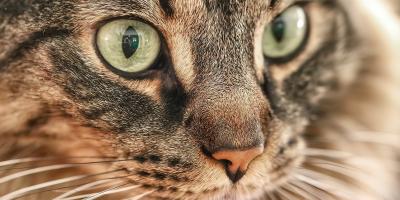
Sometimes cats do things that we, as humans, have a hard time understanding. The underlying cause for these behaviours is often related to instincts leftover from their wild ancestors.
Sitting In or On Boxes
Cats seem to love to sit on or in boxes, no matter where they are. When cats explore, one thing they are looking for is a potential hiding space. The experience of jumping and sliding into a box may resonate with their instinct to find protected spaces out in the wild where they are able to see their environment without being seen. Providing boxes and other similar spaces for your cat to climb into is an inexpensive way to enrich your home environment. Try hiding toys in these spaces, and always make sure that the environment is safe for your cat and that your cat can easily retrieve the toys from the box.
Sitting on Electronic Equipment
Cats may sit on or near electronics, like computers and TVs, because they’re warm and have stimulating images on their screens. It’s not likely that a cat can see exactly what we see, but the movement on the screen may engage her natural curiosity. Another reason your cat might sit on your TV may be that she wants interaction and attention, and is trying to disrupt the attention you are giving to the device. A good way to test this is to see if she spends as much time with a device when you are not engaging with it.
Running Around in the Middle of the Night
Since cats are nocturnal, it’s natural that they will be more active at night. Since we’re often not home during the day, they spend a lot of that time sleeping. You can help increase your cat’s activity level during the day by providing her with engaging feeding toys or by establishing a playtime routine before you leave the house and after you return. Before you go to bed, play with your cats to help them expend energy, so they can get more rest at night. A feeding routine that supplies cats with more energy during the day instead of at night might also help.
Stealing
Some cats steal almost any object they can get their paws on. If your cat receives attention from you for stealing things – even if it’s negative attention – it may teach her to continue doing it. Another possibility is that it’s a form of play. If you think this is the case, try providing something else for your cat to do, like feeding puzzles, toys to play with, or, even better, establish a playtime routine. This might alleviate any boredom that causes her to get into trouble.
Stealing may also be related to texture. Your cat may enjoy the mouth feel of different textures, and be looking for stimulation in an environment that doesn’t provide enough enrichment.
Another possibility is that your cat is experiencing stress and is stealing things that help her calm down. behaviours like wool-sucking, for example, have been observed in some cats and are suspected to calm them down.
If your cat is taking things and moving them around – like socks – it could be a predatory instinct, and the sock is being used as a replacement for prey that has been killed and brought back. If you believe that this behaviour is a compulsion for your cat you should seek the help of a cat behaviourist or a veterinarian.
Attraction to Water
Many cats love water, although they don’t respond to it the same way dogs do. Cats prefer to approach water on their own terms, and often dislike having it imposed on them. When it comes to drinking water, cats are often more attracted to running water or droplets of water because that’s one way they interact with it in nature. Still water in a bowl is less likely to gain their attention since they can’t smell it or see it as well. If you’re worried about your cat being properly hydrated, try experimenting with ways to give her access to running or dripping water.
Related articles



